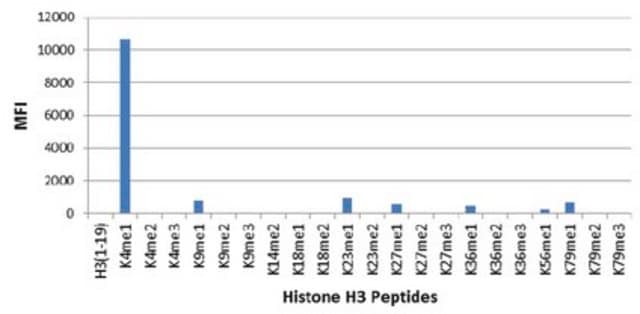MABE986
Anti-PTB Antibody, clone BB7
clone Bb7, from mouse
Synonym(e):
Polypyrimidine tract-binding protein 1, PTB, 57 kDa RNA-binding protein PPTB-1, Heterogeneous nuclear ribonucleoprotein I, hnRNP I, PTB
About This Item
Empfohlene Produkte
Biologische Quelle
mouse
Qualitätsniveau
Antikörperform
purified antibody
Antikörper-Produkttyp
primary antibodies
Klon
Bb7, monoclonal
Speziesreaktivität
mouse, human
Methode(n)
immunocytochemistry: suitable
immunoprecipitation (IP): suitable
western blot: suitable
Isotyp
IgG2bκ
NCBI-Hinterlegungsnummer
UniProt-Hinterlegungsnummer
Versandbedingung
wet ice
Posttranslationale Modifikation Target
unmodified
Angaben zum Gen
human ... PTBP1(5725)
Allgemeine Beschreibung
Immunogen
Anwendung
Epigenetik & nukleäre Funktionen
Nuclear Receptors
Immunocytochemistry Analysis: A 1:500 dilution of this antibody detected PTB in HeLa, HUVEC, and NIH/3T3 cells.
Immunoprecipitation Analysis: A representative lot immunoprecipitated PTB in HeLa and WERI-1 nuclear extracts. (Chou, M.Y., et al. (2000). Mol Cell. 5(6):949-57).
Western Blotting Analysis: A representative lot detected PTB in HeLa and WERI-1 nuclear extracts (Sharma, S., et al. (2005). Mol Cell. 19(4):485-496).
Qualität
Western Blotting Analysis: 1.0 µg/mL of this antibody detected PTB in 10 µg of HeLa cell lysate.
Zielbeschreibung
Physikalische Form
Lagerung und Haltbarkeit
Sonstige Hinweise
Haftungsausschluss
Sie haben nicht das passende Produkt gefunden?
Probieren Sie unser Produkt-Auswahlhilfe. aus.
Lagerklassenschlüssel
12 - Non Combustible Liquids
WGK
WGK 1
Flammpunkt (°F)
Not applicable
Flammpunkt (°C)
Not applicable
Analysenzertifikate (COA)
Suchen Sie nach Analysenzertifikate (COA), indem Sie die Lot-/Chargennummer des Produkts eingeben. Lot- und Chargennummern sind auf dem Produktetikett hinter den Wörtern ‘Lot’ oder ‘Batch’ (Lot oder Charge) zu finden.
Besitzen Sie dieses Produkt bereits?
In der Dokumentenbibliothek finden Sie die Dokumentation zu den Produkten, die Sie kürzlich erworben haben.
Unser Team von Wissenschaftlern verfügt über Erfahrung in allen Forschungsbereichen einschließlich Life Science, Materialwissenschaften, chemischer Synthese, Chromatographie, Analytik und vielen mehr..
Setzen Sie sich mit dem technischen Dienst in Verbindung.







